Are massage guns effective- debunking the myth
Massage guns are heavily marketed as a substitute for professional therapists, providing benefits such as sports recovery and pain... Read Article
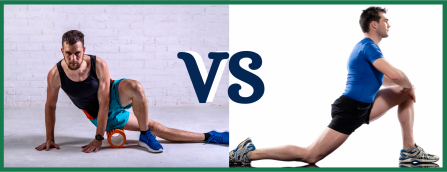
Both stretching and foam rolling are commonly used to:
So, which should you use? We reviewed 49 separate clinical trials and studies covering these, and found that some uses they were good, while others are a waste of time and can even hurt you. We also found that a lot of information provided by marketers is misleading, and in many cases there are better alternatives.
In this article, for each of the things people commonly use foam rolling and stretching for we will share with you:
Conventional stretching is probably the “benchmark” procedure for increasing flexibility. It gives a significant and prolonged increase in the length of muscles, allowing for and increased range of joint movements (1,2).
The trials also show that foam rolling initially increase flexibility, but this increase only lasts less than 10 minutes (3–5). It seems pointless spending 10-15 minutes foam rolling only to have the increase in flexibility disappear by the time you compete.
For an overall increase in flexibility conventional stretches would be the best choice. However, if done before sports or a workout there are a couple of risks.
According to the clinical trials the best ways to increase flexibility during a warm-up are a Dynamic warmup (6) vibration massage ( not a massage gun) (7).
More information on dynamic warm-ups
More information on vibration massage
Warm-ups are done before exercise or competition. The main goals are to help prepare muscles to prevent injuries and to enhance performance.
The theory behind injury prevention is that if tight muscle are forced to lengthen they may tear. likewise a restricted joint may be injured if forced too far. Lengthening muscles to their normal operational length and ensuring all joints are able to move fully is said to reduce this risk.
Advocates claim performance can be improved by things such as increasing blood flow and raising the temperature of muscles.
Clinical trials have not shown that stretching decreases the rate of injuries (8,9). Scientist speculate that this is because stretching can have both positive and negative effects, which appear to cancel each other out. While lengthening muscles will decrease their likelihood of straining and tearing, stretching too much can allow joints to move more than their usual range, which will make them more vulnerable to being injured. From this it appears that if you do stretching before sports or exercise you should only stretch as far as your joints would normally move.
Trials show that conventional stretching will actually decrease performance (1,9).
To our knowledge there have been no trials where foam roller have been used to decrease injuries. However, as foam rolling has been shown to only give a very short lived increase in flexibility they are hardly likely to help reduce injuries.
Most clinical trials show that foam rolling either gives no increase in performance, or a very small reduction (3,10–14)
Clinical trials have shown that genuine vibration massage will enhance strength (15,16), and increase the time taken for muscles to fatigue (17). More information on vibration massage
Dynamic warmups were also shown to help performance, with one trial actually increasing the height an athlete could jump by 2” (5cm) (18). More information on dynamic warm ups
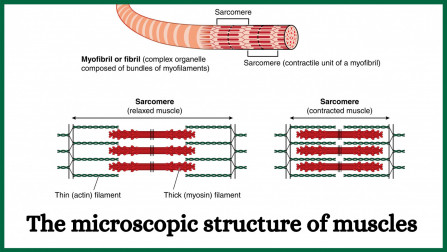
After strenuous exercise you will likely feel feel a bit stiff and sore, and your muscles will not be capable of their normal performance. This happens because strenuous exercise will do microscopic damage to the muscle’s microscopic fibres. From this you end up with:
Note: the most common post exercise muscle soreness is called Delayed Onset Muscle Soreness, or DOMS for short.
Clinical trials show that stretching has only a miniscule affect on post exercise soreness (19)

Despite being heavily marketed a recent review of 21 studies concluded that any improvements were minor or negligable (20), while others expressed concern about the potential for foam rollers to cause damage (21).
Rather than just rely on a single therapy we recommend that you use a complete strategy to help provide everything your muscles need to recover. This includes adequate rest, hydration, nutrition plus various other things you can do to help. For more details please see our article The practical science based guide to post exercise recovery .
As shown below in the clinical trials of conventional massage for post exercise some gave improvements while others did not. If your sports club provides massages afterwards it will probably feel good and you may potentially get some minor benefits.
Vibration massage ( not a massage gun ) has produced by far the most benefit in clinical trials. We found nine studies where vibration massage was used after exercising. They consistently showed that this:
This is where a vibration massager (not a massage gun or percussion massager) vibrations are used to to penetrate and have their therapeutic effects. It is very similar to the way ultrasound works. Ultrasound is just vibrations at a higher frequency. Therapeutic vibration massage has several huge benefits.
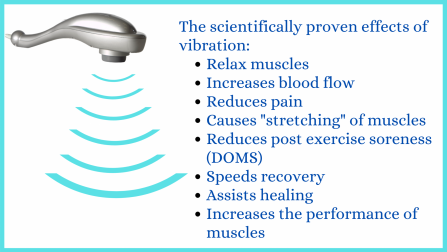
Science has found that vibrations in the therapeutic range of 30-60 Hz (cycles per second) have excellent therapeutic effects. For more information please see our article The scientifically proven effects of vibration massage- with clinical applications .
Just like ultrasound professional standard therapeutic vibrations penetrate very deeply without having to push the head into the tissues. They have no trouble reaching deep into any muscle, including spots that are difficult or impossible to access using conventional massage.
Because it is the vibrations that penetrate there is no need for the physical pressure that causes pain and can easily cause injury or damage.
There is no need to know any special massage to do vibration massage. Basically all you need to do is sit the head of an appropriate vibration massager on the part to be massaged and let the vibrations penetrate. As long as you hold the machine in the right spot it will do the same job as if a professional was holding the handle.
Warning about massage guns and "consumer massagers"
As we have seen genuine therapeutic vibrations provide will provide excellent benefits for both warming up and recovery. Marketers of massage guns and the flood of vibrating consumer massagers on the market will claim these benefits because their machines vibrate. The reality is that these are not powerful enough and/or use ineffective percussion (discussed later) so they do not deliver professional standard therapeutic vibrations (48). To find a genuine vibration massager please see our article How to choose a massager .
For information about how to use a genuine vibration please see our Vibration massage usage guide .
Dynamic warm-up means doing movement or activities. Examples include walking or exercising. This has been show to increase flexibility and strength (6). The most beneficial dynamic warm-ups involve activities and movements that mirror the requirements of your sport rather general movements (18).
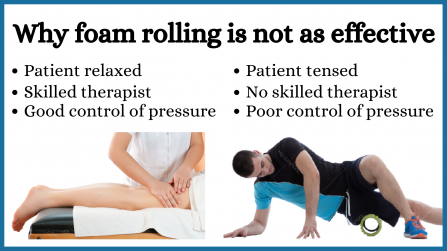
Foam rollers are heavily advertised, and promote self massage. However, as we discussed in the scientific results are very poor. This infographic shows the main reasons why.
These clinical trial results represent the best possible outcome under ideal circumstances. Patients are chosen for suitability, had a professional determine the appropriate techniques, then given excellent instructions and supervision. In the real world people use them without professional instructions and supervision, often on conditions where foam rolling is inappropriate.
Percussion massagers are vibrating tools designed to drive their heads into the muscles like a jackhammer (some up to 16 mm). Marketers claim that this combines the benefits of vibration and conventional massage. The reality is that they do neither well, and driving a head into the muscle like a jackhammer is a potentially very dangerous thing to do. There is even a report in a journal of a person nearly dying from injuries caused by using a percussion massager to help recover after cycling (49).
Unfortunately massage gun marketing is highly deceptive, causing people to spend a lot of money on equipment that is not very effective and potentially dangerous. To help you understand we will use an analogy to show exactly what percussion massagers are, then highlight two commonly used deceptive claims.
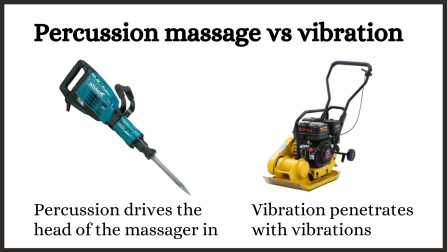
The simplest way to explain percussion is to use the analogy of a jackhammer vs a construction compactor (pictured). Both vibrate, but one is designed to send vibrations deep in the ground while the other uses those vibrations to drive it’s head into the ground and smash things.
Marketers of massage guns claim all the therapeutic benefits of vibration. However, like jackhammers percussion massagers are poor at delivering those therapeutic vibrations. Their effects from therapeutic vibrations will be minimal, and certainly not that one would get from a genuine vibration massager. As further deceptive conduct, in recent trials using percussion massagers the researchers have modified the machines using a soft or damper head to try and make them work more like a vibration massager.
By having their heads drive into the muscle massage gun marketers claim higher penetration. The reality though is that it is the therapeutic vibrations not the head driving in that has the benefits. Just like ultrasound, therapeutic vibrations will travel deep into your muscles without any need to have the head penetrate. The vibrations from genuine vibration massagers penetrate much deeper than the head of any percussion massager. For more details about the deceptive claims made about massage guns please see our article Is percussion massage scientific .

DrGraeme massagers were originally built by Dr Graeme for use in his clinic, and to prescribe to his patients for additional self use at home. Now these are used by colleagues and other professionals for similar purposes. If you are a professional and wish to know more about this therapy, or possibly get a sample massager to trial please check out our practitioner page .
We are continually adding more information on research and uses. Subscribe below to have us email them to you "hot off the press".

Several years ago Dr Graeme, a Chiropractor practicing in Victoria, Australia was looking for a serious hand held massager his patients could use at home to get the extra quality massage they needed. The ones he found in the shops and on-line for home use looked nice but were not serious, and... read more
Massage guns are heavily marketed as a substitute for professional therapists, providing benefits such as sports recovery and pain... Read Article
Massage is said to help healing and recovery. It certainly does, and in this article I’ll show you scientific evidence of some pretty... Read Article
Treating or releasing trigger points yourself is actually extremely easy. With a bit of instruction and practice you can easily find the... Read Article
Massage therapy has been shown by clinical trials to be an excellent therapy for fibromyalgia. This is because the muscular problems... Read Article
Both stretching and foam rolling are commonly used to increase flexibility, prepare muscles for a workout, and to help recover... Read Article
Most professional athletes and sports clubs make heavy use of massage type treatments. The ability to do self massage using a hand held... Read Article
To become fitter, stronger and faster your need to push your body to create the microscopic damage that stimulates improvement. That... Read Article
If you’ve got a headache it would be nice if you do some massage or press pressure points rather than rely on drugs or other therapies. ... Read Article
Do not refresh or leave this page until loading complete.